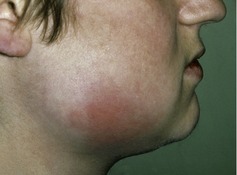Case• 32. A swollen face and pericoronitis
SUMMARY
A 23-year-old woman presents in your hospital casualty department with a painful swelling of the right side of the face and neck. What is the cause and what treatment would you provide?
 |
| Fig. 32.1. |
| The patient on presentation. |
Further information on the diagnosis of soft tissue infection will be found in case 49.
History
History of complaint
The patient has suffered worsening pain ‘from her wisdom tooth’ on the lower right side for 5 days. There has been some swelling of the gum around the tooth and she has been unable to bite together for a couple of days. Yesterday she noticed pain in the floor of her mouth and found that moving her tongue was painful. Today she awoke to find the facial swelling, she feels unwell and has difficulty eating, swallowing and opening her mouth.
She had an episode of pericoronitis a few months ago and is on her local hospital waiting list to have all third molars extracted. Until the swelling developed, she thought this was just another attack of pain from her wisdom teeth. She has not had facial swelling before and has come straight to hospital.
Medical history
The patient is otherwise fit and well.
Examination
Extraoral examination
There are palpable tender lymph nodes in the upper deep cervical chain and submandibular triangle. Opening is limited to 15 mm interincisal distance.
There is swelling below and around the lower border and angle of the mandible and extending back towards the neck. The swelling is hot, tender and very firm and a dusky red colour centrally. The swelling is not pointing to the skin. There is a marked halitosis.
Intraoral examination
Trismus hampers examination. The lower right third molar can be seen to be partially erupted, the operculum is swollen and pus exudes from below it on gentle probing. The second and third molars appear caries-free.
The floor of the mouth is very tender and firm on the right side.
▪ What additional examinations or investigations would you perform? Explain why.
It is extremely important to take the patient’s temperature to determine whether the infection is exerting systemic effects.
She has a temperature of 37.8°C (normal temperature 36.8°C) and is, therefore, pyrexic.
There is a need to confirm that pericoronitis is the cause. It would be prudent to exclude the possibility that this is infection from a nonvital molar and tests of vitality should be performed. If there were a suggestion from the examination that a lower molar was nonvital, a radiograph might be indicated, otherwise radiographs would provide little useful information for diagnosis unless another lesion were present.
Diagnosis
▪ What do these findings tell you?
The combination of inflammation (swelling, pain, redness and heat) together with local lymphadenitis and pus seen intraorally indicate an infection. Pericoronitis is present and this appears to be the primary source of the infection. Trismus is an important sign, indicating that the infection or inflammation has spread to involve the muscles of mastication.
The patient is pyrexic and feels unwell. These features indicate that the infection is exerting a systemic effect. Infection appears to be spreading relatively fast because the swelling has appeared overnight and there are already systemic signs.
▪ Which type of infection is this?
It is difficult to tell because the tissues involved are deeply sited. Pus is draining from under the operculum indicating abscess formation, but this might extend into a soft tissue space or be limited to the tissues around the unerupted tooth. The rapid spread, firmness and tenderness of the tissues (‘brawny’ swelling) indicate cel/>
Stay updated, free dental videos. Join our Telegram channel

VIDEdental - Online dental courses


